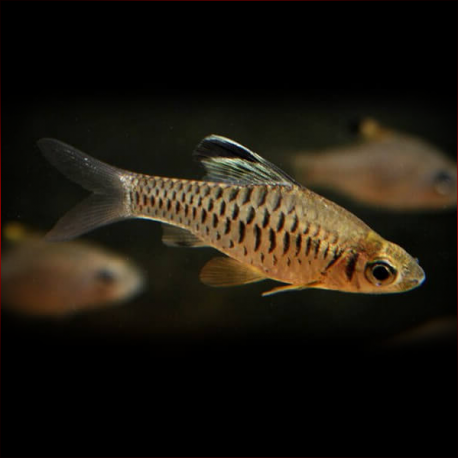More info
Datasheet
| Minimum Tank Size | 60 litres / 15.85 US gallons |
| Maximum Size | 4.3cm / 1.69inches |
| Temperature | 24°C / 75.20°F - 28°C / 82.40°F |
| Hardness | 5.04dgH / 90ppm - 15.02dgH / 268ppm |
| pH | 6.5-7.5 |
General Description
An assortment of undescribed Oreichthys spp. from India, Myanmar, and Thailand are commonly traded as O. cosuatis, with defining features such as the absence of a black blotch on the caudal peduncle and specific scale patterns. These small, stout fish with specialized body structures demonstrate intricate pharyngeal teeth arrangements, distinctive dorsal-fin markings, and observable sensory pores in unique areas on their bodies, setting them apart from other cyprinids. The genus Oreichthys is characterized by its diminutive size, compressed body shape, lack of barbels, and specific fin ray counts and arrangements.
Aquarium Setup
For optimal care, Oreichthys species like O. cosuatis thrive in well-decorated aquariums with aquatic plants, woody structures, and floating vegetation to create a soothing environment. Soft substrates are recommended due to the fish's delicate sensory bristles. Maintaining gentle filtration and water flow is essential, with water parameters falling within a pH range of 6.5-7.5, hardness between 90-268ppm, and a temperature of 24-28°C (see table).
Behaviour
While Oreichthys species are gregarious, they exhibit shoaling behavior rather than schooling tendencies, establishing pecking orders within groups. In captivity, rival males display intriguing sparring behaviors. It is best to keep them in groups of eight or more to maintain their social dynamics. Inadequate space or small numbers can lead to dominance issues and bullying among subdominant individuals.
Feeding and Diet
O. cosuatis are known to be somewhat reluctant feeders initially but readily accept a varied diet. While they can consume dry foods, their diet should include live and frozen options like Daphnia and Artemia for optimal coloration and breeding stimulus. Small, frequent meals of live or frozen fare are recommended to sustain their health and vibrancy.
Reproduction & Dimorphism
Reproduction details of Oreichthys species are currently unrecorded. Males tend to grow slightly larger than females, display enhanced coloration on their bodies and fins, and develop elongated dorsal fins. Sexually mature females exhibit a rounder belly compared to males, indicating subtle visual differences between the sexes.
Habitat and Distribution
O. cosuatis are prevalent in slow-moving sections of tributaries, minor rivers, and headwaters with abundant marginal vegetation and clear water. Their distribution spans the Ganges and Brahmaputra River basins in Nepal, India, and Bangladesh, with probable occurrences in Thailand, Myanmar, and the Western Ghats mountains in southern India, possibly representing distinct but undescribed species. Some records suggest regional limitations to the states of Uttar Pradesh, West Bengal, and Assam in India.

